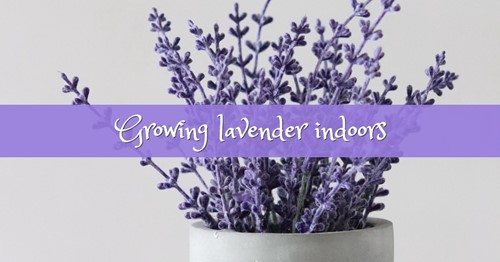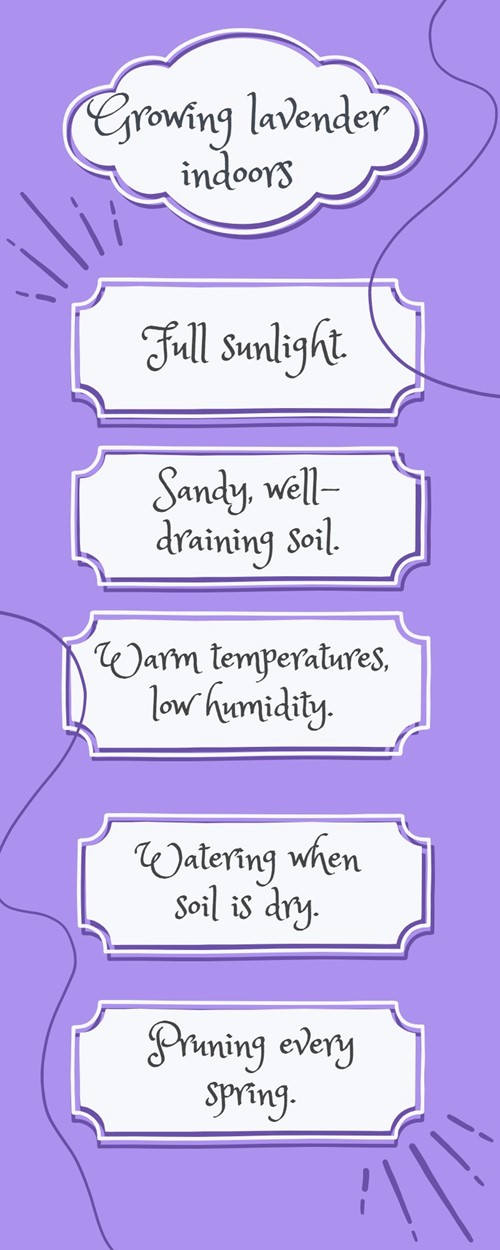Email: [email protected]

Learning how lavender grows can be your ticket to a calming and fragrant home. While lavender is frequently planted outdoors, it can also grow successfully in containers inside. If you’re interested in growing a lavender plant indoors as a houseplant, here are the most important things to know:
Growing lavender requires plenty of direct sunlight. Lavender plants thrive where they can get at least six hours of full sunlight per day. When growing lavender indoors, place your plant in front of a south-facing window. Otherwise, you may need to move the lavender around to follow the best possible sun exposure.
Lavender plants genuinely like “poor” quality soil without any organic matter. Lavender likes to have well-drained soil that’s more sandy than soft. This makes normal indoor potting mix perfectly fine for growing lavender, especially formulas meant for cacti and succulents. You can always add sand or other amendments to improve drainage.
Lavender plants typically grow best in hot, dry environments. When growing it indoors, this means you’ll want to keep it somewhere temperatures are consistently high but with plenty of airflow.
Too much humidity is more of a risk than lower temperatures, however; keep your lavender somewhere with good air circulation and out of steamy areas like bathrooms and kitchens.
Because too much moisture can cause problems for lavender plants, it’s best to water only when the soil feels dry. You can use a moisture meter to test below the surface to ensure the soil is draining properly.
The only exception to this is when the plant is brand new and first becoming established: during the first growing season, water frequently instead of letting the soil dry out too long in between.
Lavender flowers and buds will grow naturally as long as the soil is sufficiently lacking in organic matter. Adding fertilizer or compost will instead encourage the plant to focus energy on its gray green foliage and structure rather than blooms. For the best lavender flowers, prune every spring to encourage new buds to form.

If you want to plant lavender and enjoy its aromatic blooms inside your home, following these tips will help you achieve your goals. With the right balance of warmth, light and well drained soil, you can grow lavender in containers just as well as outside in your garden.

With strong connections to her community, Mary-Lou has held fund-raising events for The National Multiple Sclerosis Society, The Kids in Need Foundation and Dress for Success. This sense of personal responsibility extends to her professional life, and she continuously strives to exceed her clients’ expectations, empowering them throughout selling or buying process. "Only a well-informed client is prepared to make the best decisions on their own behalf, so the role of Market Expert is one I take very seriously.” It is this sense of personal accountability that drives Mary-Lou; keeping her focused on her clients and providing them with highest level of professionalism, solution-focused service, and sound guidance from start to SOLD!
Mary-Lou McDonough is Professionally Affiliated with The MASSACHUSETTS ASSOCIATION OF REALTORS® The GREATER BOSTON REAL ESTATE BOARD, THE NATIONAL ASSOCIATION OF REALTORS®, The Women’s Council of REALTORS®, The State and National Association of Certified Residential Specialists and The REALTORS® Political Action Committee
Whether you're in the research phase at the beginning of your real estate search or you know exactly what you're looking for, you'll benefit from having a real estate professional by your side. I'd be honored to put my real estate experience to work for you.